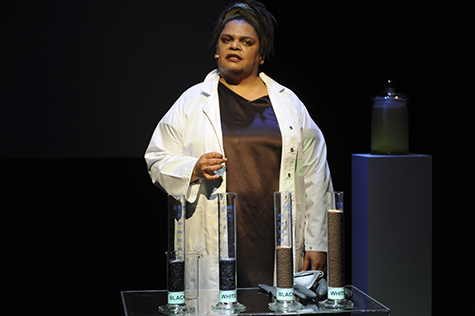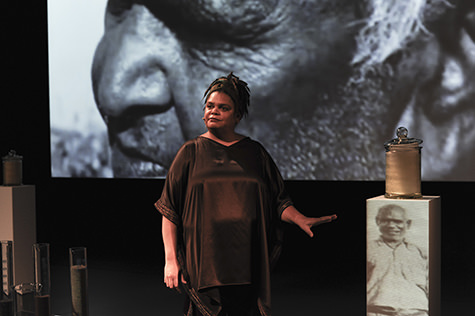One heart beating for the many
Keith Gallasch: Romaine Moreton, One Billion Beats

Romaine Moreton, One Billion Beats
photo Heidrun Löhr
Romaine Moreton, One Billion Beats
A large-scale screen fills the rear of the stage; a small one sits to the right. There are several plinths and a table, each holding large glass laboratory bottles, and a rusted corrugated iron trough of the kind used to water cattle. We are in an intimate space, where the story of a life will unfold against huge images from films that have in part shaped it.
When Romaine Moreton, a Goenpul Jagara woman of Stradbroke Island and Bundjulung of northern New South Wales, turns poet in One Billion Beats, I’m totally captivated by her deep, rich voice, her poems’ memorable images and forthright pronouncements, their end rhymes, internal rhymes, assonance and the extended, incantatory vowels of the Beats, the emphatic pulse of hip-hop and the poet’s increasing inclination to rise above speech and soar towards song as the performance goes on. Yorta Yorta Dja Dja Wurrung woman Lou Bennett’s spare, characterful scoring underlines the poetry’s inherent beat while layering it with sounds from nature and inflecting it with a variety of musical forms.
There are many other beats in this work, those of the hearts of the generations from whom Moreton is descended and whose lives she resurrects in her vivid autobiographical storytelling which alternates with her recitations. Her life has been complex from the earliest years on a farm to separation from her mother at age six, absorption into a caring network of kin, school challenges, the relentless pressure of racism and, later, enlightening if sometimes alarming research. Moreton is no lost soul. At one with her family and her culture, she thanks her mother for letting go of her, opening the child to a wider urban world of aunts and uncles.
It was her schooling that revealed to Moreton that she was different. She and other Aboriginal children were separated out, labelled ‘dirty’ and forced to shower. As well the headmaster’s sarcasm towards his black students about their competency “ensured we inherited his racism, the trick of it,” says Moreton. It’s this cultural “trick” of racism that Moreton, the scholar, goes on to explore in her maturity. She clearly owns her personal history, but yearns to see it in a larger context, to explain the persistent oppression of Australia’s Aboriginal peoples. She turns to popular culture: feature films made over the last 100 years in which Aboriginal people are for the most part consistently stereotyped and marginalised by white filmmakers, but which include the complexly ambiguous Jedda (Charles Chauvel, 1955) and Indigenous filmmaker Warwick Thornton’s Samson and Delilah (2009). As we watch Delilah lovingly wash Samson in a cattle trough, Moreton gently ladles water hand to hand from her own that sits onstage, an image resonant with that film’s sense of care and possible liberation. The trough also evokes water as a commodity historically competed for by Indigenous people and white men’s cattle (their presence overwhelming in the stampede excerpt from Baz Luhrmann’s Australia [2009]).
Moreton conducted her film research over three months in 2009 at the National Film and Sound Archive in Canberra, where a particular encounter added another layer of telling and image-making to One Billion Beats. The building was formerly the Australian Institute of Anatomy and reputedly haunted. In a chilling episode Moreton recounts experiencing, while in-residence, a vision of Sir Colin Mackenzie, the one-time director of the institute and collector of Australian native animals which he dissected and preserved in jars of formalin. She sees him coming at her with a scalpel (Bennett’s sound design includes the shrill sharpening of a knife). “I feel the pain and wake,” says Moreton. Heightening her sense of being a mere specimen (Aboriginal remains were also part of the collection), Moreton appears onscreen, a drawing of a measuring device hovering about her head. In the 19th century, scientists were determined to define race types, criminals and the insane via the pseudoscience of craniology, also known as phrenology, as Moreton discovered at the Royal College of Surgeons in London, also in 2009. Donning a white lab coat, she takes on a key player and founder of the notion of ‘cranial capacity,’ Samuel George Morton (1799-1851), by delivering a mock demonstration of his theory.

Romaine Moreton, One Billion Beats
photo Heidrun Löhr
Romaine Moreton, One Billion Beats
In One Billion Beats’ film excerpts Indigenous people are for the most part simply displayed as cultural specimens, bereft of social status or narrative power. In institutional studies, they are merely scientific specimens, to be collected, defined and otherwise rejected. Towards the end of the performance, the stage darkens and the plinths become screens on which appear Indigenous people, ghost-like, but affirming the reality of the lives Moreton has invoked. They, and Moreton are, of course, not the specimens she fears they have become; they are the billion beats of tightly knit generations, past and present. Hence, Truganini, so-called ‘last of the Tasmanians,’ looks calmly out at us from the screen as Moreton says of the racist culture she has revealed to us, “ideological warfare more difficult still” than “the bullets we dodged.” But with pride, against slow, sombre strings, she iterates the chorus to her final poem, “We are here and we are many and we shall surprise you by our will.”
It’s interesting to note that while making a case against the discriminatory legacies of popular culture and science, Moreton distances herself and her people from short-term politics. An 80-year-old aunt tells her firmly that “skin,” not political movements, defines Aboriginality and that she was Aboriginal long before the invention of the Aboriginal flag. Moreton’s is therefore the long view, both of generations and of the history of discrimination. One Billion Beats is most certainly a performance with a message about enduring ideological manipulation, but being rooted in the specifics of experience and delivered with an idiosyncratic voice it is a message to especially value.
Co-directors Romaine Moreton and Alana Valentine’s lucid staging of One Billion Beats has Moreton moving in simple patterns about the stage (designed by Moreton and Sean Bacon), engaging effectively, episode by episode, with screen images, the trough, her ‘laboratory’ and her audience. Lou Bennett’s evocative sounds, Hugh Hamilton’s intimate lighting and Sean Bacon’s video design (of the film excerpts but also of the landscapes of a childhood including a haunting, misty valley of eucalypts) gently texture and enrich the performance. As co-writers, Moreton and Valentine have judiciously balanced the delivery of poems and stories, the writing in the latter as lucid as their staging, although the volume of information and keeping track of who’s who in the young Moreton’s expanding world is occasionally daunting.
Long after I experienced it, One Billion Beats continues to resound with the beating of hearts, poems and music, its engaging performer sharing with us her distinctive life, deep feelings and her intellectual challenge to racism.
–
One Billion Beats, writer-directors Romaine Moreton, Alana Valentine, music, sound Lou Bennett, video design Sean Bacon, set Moreton, Bacon, lighting Hugh Hamilton, producer Campbelltown Arts Centre, associate producer Vicki Gordon; Campbelltown Arts Centre, 26, 27 Feb, 4, 5 March
RealTime issue #131 Feb-March 2016, web






